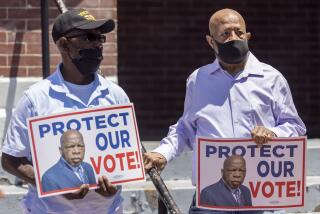The Klan is still dead
RECENT NEWS headlines announce a revival of the Ku Klux Klan. The Christian Science Monitor warns that the KKK “appears to be on the rise again after years of irrelevance.” The Associated Press reports that white supremacists are “significantly more active” and are “focused on stirring anti-immigrant sentiment,” particularly against Mexicans and other Latinos.
The stimulus for these stories is a 13-page report from the Anti-Defamation League, a Jewish organization that has long fought all forms of bigotry. The ADL says the Klan “experienced a resurgence in 2006,” with “a noticeable spike in activity by Klan chapters across the country.” All told, the ADL estimates that there could be as many as 5,000 members and associates of the KKK spread across the country.
So is it time to be worried? Is the ADL correct in warning of a dangerous resurgence of the dreaded and widely hated organization that committed so many acts of terror against African Americans during Reconstruction and the civil rights era?
It’s not so clear. The ADL document identifies several Klan groups as especially active in 2005-06. One is the Brotherhood of Klans, based in Henderson, Tenn., which sponsored a number of public events during that period — but whose leader, Dale Fox, died of a heart attack in November.
Another is the World Knights of the Ku Klux Klan, based in Sharpsburg, Md., which mustered a turnout of only about 30 Klansmen at the Civil War battlefield near Gettysburg, Pa., in September. World Knights leader Gordon Young “used the event to denounce multiracial marriage and immigration,” the ADL reports. Two months later, however, the World Knights unexpectedly disbanded, and in January, Young was arrested on multiple felony charges of sexual abuse of a minor. He remains in jail on $350,000 bond and faces up to 25 years in prison if convicted.
Even the ADL acknowledges that “many individual Klan groups themselves typically do not last long before fragmenting or falling apart,” and it admits that nationwide the KKK is “extremely fragmented” with “little” financial support.
Yet the report seems determined to make things sound as bad as possible. For instance, it highlights the Empire Knights of the Ku Klux Klan, a group formed in 2005 whose website claims it has “realms” in 20 states reaching from Massachusetts to California.
The ADL’s emphasis on the Empire Knights failed to impress Florida’s St. Petersburg Times, the major newspaper closest to the Knights’ U.S. headquarters. “The Anti-Defamation League says there is a Homosassa branch of the Ku Klux Klan and that it is helping lead a national Klan resurgence,” a Times story began. “This came as news to the Citrus County sheriff’s office,” the paper said. Sheriff’s investigators there “have seen no activity recently” by the Homosassa Klan, the paper reported.
ADL Florida regional director Andrew Rosenkranz, the Times went on, “said he didn’t disagree with local law enforcement’s observations.”
Frankly, the turnout of a mere 20 KKKers at an anti-immigration rally organized by the Empire Knights in Amarillo, Texas, in August may be indicative of the Knights’ lack of strength. The ADL emphasizes how the Knights’ website features “an Internet-based radio station which broadcasts white power music” as well as links to the 20 state “realms” — but the available evidence suggests that the “Empire” may be a Potemkin village.
Click on the Florida realm and a dead link results. Georgia, like Texas, is “under construction.” The California realm has a five-paragraph screed announcing that “we are a Klandestine Province and Empire,” but the sections on “beliefs,” “history” and “events” are likewise “under construction.” Under a category called “forum,” there’s a recipe for “beef and veggie skillet,” and under “members,” there’s a grand total of 24 registered individuals.
Maybe most Klansmen just don’t use the Web, but if the Empire Knights are indeed growing significantly, some evidence other than this tiny band of Web members or the 20-person turnout in Amarillo needs to be cited.
There’s no doubt that what Klan members there are scattered across the U.S. do manifest a hateful hostility toward Latino immigrants. I have no illusions about how dangerous these people can be, and I have no doubt that leaders of the various Klan organizations would like to use the growing hostility as a way to resuscitate their discredited ideology and rebuild their weakened, fragmented structure.
In North Carolina, the Charlotte Observer, reacting to the ADL report, contacted “imperial wizard” Virgil Griffin of Mount Holly. “The illegal immigrants are taking this country over,” Griffin said, and as a result, he claimed, his Klan’s membership is growing faster than at any time since the 1960s.
But it’s difficult to find public evidence of many violent or terrorist acts committed by the allegedly swelling ranks of Klan members. (A cross-burning on the lawn of a Salvadoran family in Kentucky, like an assault on a Latino teenager in Houston by assailants who screamed “white power,” appear to top the list for 2006, but the actual perpetrators remain unidentified.)
It can be dangerous and counterproductive to hype the threat of racist hate groups. Anti-immigrant sentiment is an undeniable feature of today’s world, and immigration issues no doubt merit more media coverage. But based on present evidence, the efforts of both KKKers and their opponents to publicize the Klan’s supposed importance should be debunked rather than embraced.
More to Read
Sign up for Essential California
The most important California stories and recommendations in your inbox every morning.
You may occasionally receive promotional content from the Los Angeles Times.









